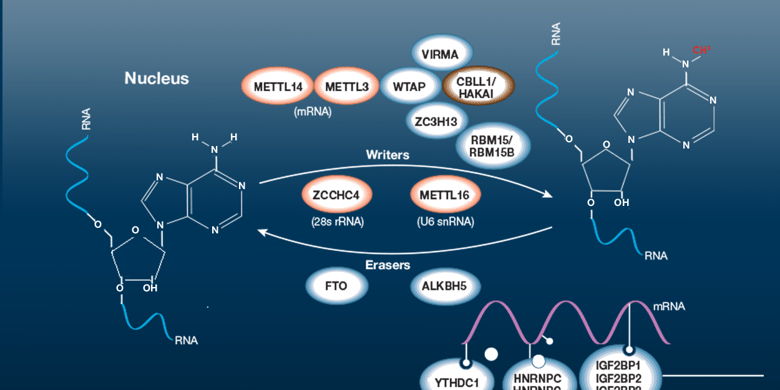Guest blogger Gina Lee, PhD, is an Assistant Professor of Microbiology and Molecular Genetics at the University of California Irvine and Chao Family Comprehensive Cancer Center. This post details the recent review paper by the Gina Lee Lab at UC Irvine: M6A in the Signal Transduction Network.
—
Cells have developed sophisticated regulation mechanisms to ensure proper development and function. While extensive research has increased our understanding of how cellular events are regulated at the gene transcription level, there is still much to learn about the hidden layer of gene regulation—the chemical modification of RNA.
N6-adenosine methylation (m6A) is the most abundant mRNA modification observed in eukaryotes. The interplay between three key components (writer, reader, and eraser) controls the m6A modification of mRNA. The m6A writer complex, comprised of the METTL3-METTL14 methyltransferase and the adaptor protein, WTAP, modifies mRNA transcripts during synthesis by methylating the adenosine base at the N6 position. Like histone epigenetic modifications, m6A methylation is a reversible process, and m6A eraser proteins, such as ALKBH5 or FTO, are responsible for removing the methyl group from adenine. M6A methylation and demethylation are dynamically regulated by cellular states and extracellular signals—such as those occurring during stem cell differentiation and maternal to zygote transition—as well as heat shock and oxidative stress.
What is the effect of the m6A modification? Due to m6A not having an electrical charge or bulk chemical groups, it does not significantly influence normal mRNA structure. M6A readers ultimately govern the fate of mRNAs by calling for the assembly of RNA metabolic enzymes. For example, the m6A reader protein, YTHDF2, recruits the CCR4-NOT deadenylase complex to induce degradation of m6A-modified mRNA.
M6A-dependent mRNA degradation is especially useful when cells need to remove certain transcripts within a short period of time. For example, during cell differentiation, transcripts from pluripotency genes, such as NANOG, must be rapidly degraded to stop self-renewal and start expressing differentiation factors. How are cells clever enough to add m6A marks to specific transcripts and then remove them during differentiation? It turns out that cells take advantage of the signaling pathway that induces pluripotency gene transcription. When TGF-β signaling is activated, it phosphorylates the SMAD2/3 transcription factors to induce the expression of pluripotency genes. Thus far, scientists have mostly focused on studying SMAD2/3-dependent transcription events. However, cells also use phosphorylated SMAD2/3 to recruit m6A writers to the newly synthesized pluripotency genes for m6A modification. This prepares the mRNA for future degradation events during differentiation. Now, isn’t that truly clever?
To learn more about other signaling pathways that utilize this hidden signal—the m6A-dependent gene regulation program—refer to our recent review paper by the Gina Lee Lab at UC Irvine: M6A in the Signal Transduction Network.
There are also useful tools to explore gene regulation mechanisms by RNA modification and signaling pathways on the Cell Signaling Technology website.




